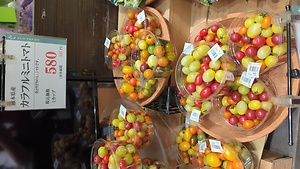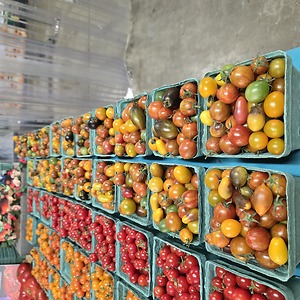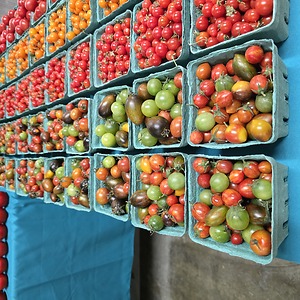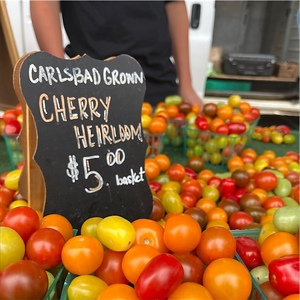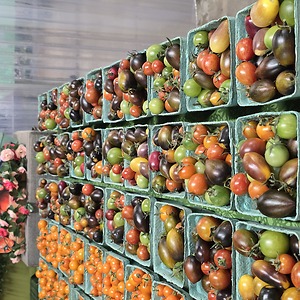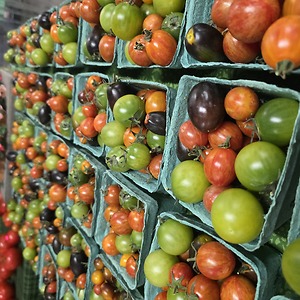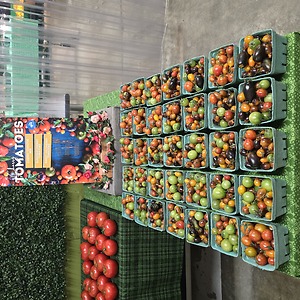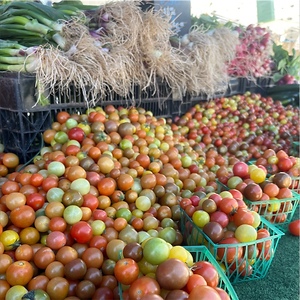


Cherry Tomatoes
Estimated Inventory, 12 ct : 57.58
This item was last sold on : 08/03/25
Description/Taste
Cherry tomatoes are small, bite-sized fruits that come in over 100 varieties. They tend to be about 2.5 centimeters wide, though they can vary in size. Cherry tomatoes can be red, yellow, orange, green, or dark purple. Their skin tends to be firm, thin, and smooth. The flesh of Cherry tomatoes is juicy and succulent. Its seed pockets are filled with yellow seeds surrounding light-colored flesh. They have a sweet, fresh, and tangy scent with a slightly earthy aroma. Cherry tomatoes are sweeter and milder in flavor than larger-sized tomatoes. They have a mild tartness that varies depending on the type of Cherry tomato.
Seasons/Availability
Cherry tomatoes are available year-round with a peak season in the summer.
Current Facts
Cherry tomatoes are botanically classified as Solanum lycopersicum var. cerasiforme and are part of the Solanaceae family. They are categorized as either an heirloom or hybrid. Heirloom Cherry tomatoes have been reproduced for generations without crossbreeding, whereas hybrid Cherry tomatoes are the result of crossing two different varieties. They are called 'Cherry tomatoes' because many varieties are roughly the size of a cherry, though some can grow up to twice that size. Most Cherry tomatoes are bred to have a juicy texture that bursts when eaten, eliminating the need for peeling, deseeding, or chopping before consumption. Cherry tomatoes are often compared to Grape tomatoes because they are both bite-sized. The difference is that as their name indicates, Grape tomatoes have a more oblong, grape shape. They also tend to have thicker skin than Cherry tomatoes. Popular varieties of Cherry tomatoes include Isis Cherry, Indigo Rose, Black cherry, Rose tomato, Lemon Cherry, Sungold, Sweet Million, and Sunrise Bumble Bee.
Nutritional Value
Cherry tomatoes contain vitamins A, C, and E. These nutrients can help with vision, skin, heart, and reproductive health, immune support, iron absorption, collagen production, and inflammation prevention. Cherry tomatoes are rich in lycopene, which may benefit bone health, limit UV damage to the skin, and potentially lower the risk of diseases like stroke, osteoporosis, and prostate cancer. Cherry tomatoes contain potassium, which can help with blood pressure regulation, fluid balance, muscle function, and bone health. Though the fruit of Cherry tomatoes is entirely edible, eating too many of them may cause acid reflux in some people due to their malic acid content.
Applications
Cherry tomatoes can be eaten fresh, steamed, sauteed, roasted, pickled, or sundried. In their raw form, Cherry tomatoes can be eaten by themselves, tossed into a salad, used in a bruschetta recipe, diced up for salsa, or served on a vegetable platter. Raw Cherry tomatoes go well with greens like spinach, iceberg lettuce, arugula, and kale and can be used in Greek, Caesar, and corn salads. They can be roasted with olive oil, salt, and pepper or blanched, peeled, and flash-blistered on the grill to give them a smoky flavor. Cherry tomatoes can be used as a topping or in the sauce of a variety of pasta dishes, such as pomodoro, baked rigatoni, risotto, and ravioli. They can be used as toppings for hot dogs or pizza or in dishes like enchiladas, frittatas, shakshuka, dal soup, and focaccia bread. Cherry tomatoes pair well with seafood like mussels, tilapia, halibut, tuna, shrimp, and salmon. They pair well with ingredients like roasted chicken, skirt steak, chorizo, sausage, bell peppers, poblano peppers, zucchini, eggplant, asparagus, corn, potatoes, chickpeas, white beans, fennel, beets, shallots, ginger, cumin, thyme, basil, mint, mozzarella, feta cheese, kalamata olives, capers, pesto, okra, cucumber, and bacon. All varieties of Cherry tomatoes should be stored away from direct sunlight at room temperature for approximately two to three days or until ripe and ready to use. They should then be refrigerated to slow the process of decay and prevent them from ripening further.
Ethnic/Cultural Info
The exact origins of the Cherry tomatoes are not known, though there are many different places where they are said to have originated. It’s thought that the first Cherry tomatoes were cultivated in South America and then brought to Europe. The Greek Island of Santorini also claims to be the first place to grow Cherry tomatoes. Israel is known for creating the first commercially viable Cherry tomatoes and perfecting many different varieties over the years. The global popularization of Cherry tomatoes occurred in the 1970s and 80s, largely due to a British grocery chain called Marks & Spencer. This company worked with Israeli breeders to develop Cherry tomatoes that were shelf-stable and distinctly sweet. Before they became popular as a standalone food, Cherry tomatoes were mainly used as a garnish.
Geography/History
Cherry tomatoes are descendants of the wild tomato, which is said to have originated in the Andes Mountains of South America. Tomatoes were then cultivated by the Incas and Aztecs around 700 A.D. which traces back millions of years to coastal South America. The first evidence of tomatoes grown as small as Cherry tomatoes dates back to the mid-early 1600s, though Cherry tomatoes were not commercialized until the late 20th century. Cherry tomatoes grow in hot and warm climates with plenty of sun exposure. They can handle humidity but do not tolerate cold weather. As a cultivated variety selectively bred to be small, Cherry tomatoes are not found in the wild but are grown commercially or in home gardens. Cherry tomatoes rose to popularity in the 1980s after being bred and marketed for their convenient small size and sweet taste. They are a popular food worldwide and can be found in grocery stores, farmers’ markets, specialty stores, and home gardens.
Featured Restaurants
Restaurants currently purchasing this product as an ingredient for their menu.
| Palmys | San Diego CA | 858-886-7111 |
| Vagabond Sportfishing Inc. | San Diego CA | 619-993-9575 |
| The Local-Pacific Beach | San Diego CA | 858-263-7475 |
| Convention Center Shell | San Diego CA | 619-954-3063 |
| Addison Del Mar | Del Mar CA | 858-350-7600 |
| Pacific Terrace Hotel | San Diego CA | 858-581-3500 |
| Venissimo Cheese North Park | San Diego CA | 619-376-1834 |
| UCSD Health East campus | San Diego CA | 619-578-3373 |
| Seneca | San Diego CA | 619-588-2411 |
| Culinary Kitchen Catering and Events | Coronado CA | 619-798-8477 |
| Portside Pier (Ketch Tasting Deck) | San Diego CA | 858-268-1030 |
| Slowly | San Diego CA | 858-352-6080 |
| Seneca Bar | San Diego CA | 619-588-2411 |
| Slice House by Tony Gemignani | San Diego CA | 925-413-3061 |
| Coronado Yacht Club | Coronado CA | 619-435-1848 |
| Milton's Delicatessen, Grill & Bakery | Del Mar CA | 858-792-2225 |
| Harumama (Little Italy) | San Diego CA | 619-269-7122 |
| Shogun Sportfishing | San Diego CA | 619-226-8030 |
| Joya Kitchen | San Diego CA | 619-255-5979 |
| Brigantine La Mesa | La Mesa CA | 619-465-1935 |
| The Guild Hotel | San Diego CA | 619-764-5108 |
| Fay's Diner and Cafe | San Diego CA | 661-858-8895 |
| Sheraton Carlsbad (7 Mile) | Carlsbad CA | 760-827-2400 |
| Under Belly-Uptown | San Diego CA | 619-269-4626 |
| Farm Fresh Meals | Vista CA | 760-707-2383 |
| Urbn Pizza Kitchen | San Diego CA | 619-255-7300 |
| Blind Lady | San Diego CA | 619-381-4475 |
| Brockton Villa Restaurant | San Diego CA | 858-454-7393 |
| Isola La Jolla | La Jolla CA | 858-412-5566 |
| Villa Capri Poway | Poway CA | 858-391-9400 |
| Grossmont-Cuyamaca Community College District | El Cajon CA | 619-644-7585 |
| Great Maple Hillcrest | San Diego CA | 619-255-2282 |
| Bencotto Italian Kitchen | San Diego CA | 619-822-5493 |
| Crust Pizzeria Carlsbad 2019 | Carlsbad CA | 760-944-1111 |
| Blue Ocean | Carlsbad CA | 760-434-4959 |
| Harney Sushi | San Diego CA | 619-295-3272 |
| Uptown Tavern | San Diego CA | 619-683-9322 |
| Green Acres Campus | San Diego CA | 858-450-9907 |
| Bar Same Same (Kitchen) | Carlsbad CA | 760-470-9143 |
| Wildflour | San Diego CA | 619-289-9240 |
| Saint Mark Golf and Resort, LLC | San Marcos CA | 508-320-6644 |
| El Sueno | San Diego CA | 619-972-6286 |
| Counterpoint | San Diego CA | 619-564-6722 |
| Boujiemana (TCW) | San Diego CA | 415-710-0510 |
| HiroNori Ramen | San Diego CA | 619-446-9876 |
| Vista Valley | Vista CA | 760-758-2800 |
| All Aboard Charcuterie & Provisions | San Diego CA | 619-994-5267 |
| Books and Records | San Diego CA | 619-310-5298 |
| Village Pizzeria Bay Side | Coronado CA | 619-522-6890 |
| SIE Culinary Management | San Diego CA | 858-964-8677 |
| Hotel Republic San Diego | San Diego CA | 951-756-9357 |
| The Country Club Of Rancho Bernardo | San Diego CA | 858-487-1134 |
| Carte Hotel | San Diego CA | 619-365-1858 |
| Biga | San Diego CA | 949-295-4377 |
| The Cottage La Jolla | La Jolla CA | 858-454-8408 |
| Syrah Spirit & Wine Parlor | San Diego CA | 619-234-4166 |
| The Farm Golf Club | Rancho Santa Fe CA | 858-756-5585 |
| Little Frenchie | Coronado CA | 619-522-6890 |
| Hotel Indigo | San Diego CA | 619-295-3172 |
| Ciccia Osteria | San Diego CA | 619-674-4069 |
| Reata Glen | Ladera Ranch CA | 949-545-2250 |
| The Haven (Pizzeria) | San Diego CA | 619-964-3778 |
| A & M catering | San Diego CA | 206-802-8320 |
| Communion | San Diego CA | 619-606-5568 |
| Stake Chophouse & Bar | Coronado CA | 619-522-0077 |
| Hilton Mission Valley | San Diego CA | 619-543-9000 |
| The Loma Club | San Diego CA | 619-222-4653 |
| Luce | San Diego CA | 619-275-2094 |
| Bleu Boheme | San Diego CA | 619-255-4167 |
| Love Boat Sushi-Oceanside | Oceanside CA | 760-721-3737 |
| Polaris Supreme | San Diego CA | 619-390-7890 |
| Cucina Enoteca | Del Mar CA | 619-239-2222 |
| Home & Away - Old Town | San Diego CA | 619-886-1358 |
| Hotel La Jolla - Sea & Sky | La Jolla CA | 858-459-0261 |
| Crust & Brew | San Diego CA | 858-212-8751 |
| Jeune Et Jolie | Carlsbad CA | 858-231-0862 |
| UCSD Food & Nutrition Department Hillcrest | San Diego CA | 619-380-9840 |
| The Victorian at Hill Street | Oceanside CA | 442-266-8285 |
| Bahia Resort Hotel | San Diego CA | 858-488-0551 |
| Pitchers | San Diego CA | 858-472-1251 |
| Nate's Garden Grill | San Diego CA | 619-607-0117 |
| Sisters Pizza | San Diego CA | 858-228-6822 |
| Casero Taqueria | Carlsbad CA | 760-533-4997 |
| Michele Coulon Dessertier | San Diego CA | 858-456-5098 |
| Le Papagayo (Encinitas) | Encinitas CA | 760-944-8252 |
| Park 101 | Carlsbad CA | 760-434-2217 |
| Pascucci Pasta | San Diego CA | 619-285-8000 |
| Brigantine Imperial Beach | Imperial Beach CA | 619-591-1350 |
| Plant Based Meals | San Diego CA | 858-255-0590 |
| Dough Momma | La Jolla CA | 858-346-6692 |
| Cutwater Spirits | San Diego CA | 619-672-3848 |
| Marriott Del Mar | San Diego CA | 858-369-6029 |
| Sisters Pizza (NP) | San Diego CA | 858-228-6822 |
| Royal Polaris Sportfishing | San Diego CA | 619-226-8030 |
| Ballast Point Rest. - Miramar | San Diego CA | 858-790-6900 |
| Red Tail Catering | San Marcos CA | 858-605-8219 |
| Coin-Op Game Room (Downtown) | San Diego CA | 619-255-8864 |
| Nolita Hall | San Diego CA | 619-618-8820 |
| Juniper & Ivy | San Diego CA | 858-481-3666 |
| Coco Maya by Miss Bs | San Diego CA | 858-245-3780 |
| Bali Hai Restaurant | San Diego CA | 619-222-1181 |
| Revolution Roasters | Oceanside CA | 760-330-6827 |
| Mille Fleurs | Rancho Santa Fe CA | 858-756-3085 |
| Bite Me Bistro | Carlsbad CA | 760-216-3874 |
| Shimbashi Izakaya | Del Mar CA | 858-523-0479 |
| Madi | San Diego CA | 320-491-1217 |
| Small Barn | Temecula CA | 951-225-2822 |
| Stout Public House | San Diego CA | 619-702-7933 |
| The Smoking Goat | San Diego CA | 858-232-4220 |
| Lumi | San Diego CA | 619-955-5750 |
| One Door North | San Diego CA | 858-232-4220 |
| Lodge at Torrey Pines Grill | San Diego CA | 858-453-4420 |
| Coast Catering | Escondido CA | 619-295-3173 |
| The Santaluz Club Inc - Banquet | San Diego CA | 858-759-3150 |
| The Bower | Coronado CA | 949-212-3192 |
| Dija Mara | Oceanside CA | 760-231-5376 |
| Public House 131 | San Diego CA | 858-537-0890 |
| Humphrey's | San Diego CA | 619-224-3577 |
| Pendry SD (Lion Fish) | San Diego CA | 619-738-7000 |
| Better Buzz Coffee (La Jolla) | La Jolla CA | 619-269-4022 |
| DoubleTree By Hilton San Diego | San Diego CA | 619-881-6900 |
| The Flavor Chef (Catering) | Vista CA | 619-295-3172 |
| Sandpiper Wood Fired Grill & Oysters | La Jolla CA | 858-228-5655 |
| Prey Brewing Company | Vista CA | 760-822-4226 |
| Harumama Noodles & Buns (Encinitas) | Encinitas CA | 858-886-9909 |
| The Harvest Honey | San Marcos CA | 616-914-0124 |
| 619 Spirits | San Diego CA | 509-701-9534 |
| Alexander's on 30th | San Diego CA | 858-774-3062 |
| Order Fire Barbecue | Santee CA | 619-768-3986 |
| Kensington Cafe | San Diego CA | 619-684-0044 Fausto |
| The Field Irish Pub & Restaurant | San Diego CA | 619-232-9840 |
| Bernardo Heights Country Club | San Diego CA | 858-487-4022 |
| Mitch's Seafood | San Diego CA | 619-316-7314 |
| Toast Catering | San Diego CA | 619-795-9135 |
| Portside Pier (TopSail) | San Diego CA | 858-268-1030 |
| The Tavern | Coronado CA | 602-628-5890 |
| KI's | Encinitas CA | 760-586-8289 |
| Il Giardino di Lilli | La Jolla CA | 619-467-9897 |
| Encontro North Park | San Diego CA | 310-955-6333 |
| Blue Ocean La Jolla | La Jolla CA | 858-999-0323 |
| The Remy | San Diego CA | 619-886-1358 |
| Mavericks Beach Club | San Diego CA | 858-999-0348 |
| Solterra Winery + Kitchen | Encinitas CA | 858-245-6146 |
| Moxy San Diego Gaslamp | San Diego CA | 619-376-1850 |
| Q&A Oyster Bar & Restaurant | Oceanside CA | 858-245-3780 |
| Brigantine Del Mar | Del Mar CA | 858-481-1166 |
| Harumama Noodles & Buns (Carlsbad) | Carlsbad CA | 760-637-5737 |
| Lodge at Torrey Pines Main | San Diego CA | 858-453-4420 |
| Village Pizzaria | Coronado CA | 619-522-6890 |
| Crudo Cevicheria & Oyster Bar | San Diego CA | 619-313-9127 |
| Daffodil Cafe | San Diego CA | 858-461-7788 |
| Chateau La Jolla | San Diego CA | 858-459-4451 |
| Brigantine Coronado | Coronado CA | 619-435-4166 |
| South O Brewing Catering | Oceanside CA | 925-381-5392 |
| The Wild Thyme Company | San Diego CA | 858-527-0226 |
| Jack & Giulio's | San Diego CA | 619-294-2074 |
| Savory Moment (1) | Carlsbad CA | 619-633-8863 |
| Blue Ocean Sushi & Grill (UTC) | San Diego CA | 858-886-9909 |
| Zoya | La Jolla CA | 619-942-3396 |
| Bayhill Tavern | San Diego CA | 858-288-6923 |
| Caffe Calabria Coffee Roasting Company | San Diego CA | 619-683-7787 |
| C 2 C | San Diego CA | 619-972-9345 |
| Belmont Park Draft | San Diego CA | 858-228-9283 |
| Fort Oak | San Diego CA | 619-795-6901 |
| Coya Peruvian Secret | Del Mar CA | 619-295-3172 |
| Firefly Beach | San Diego CA | 619-222-6440 |
| Park Commons - ARE | San Diego CA | 619-295-3172 |
| Glenbrook Health Center | Carlsbad CA | 760-704-1000 |
| Menya Ultra (Mira Mesa) | San Diego CA | 619-889-4566 |
| Hilton La Jolla Torrey Pines | La Jolla CA | 858-450-4581 |
| Beach Plum Kitchen | Carlsbad CA | 760-688-8682 |
| Menya Ultra (La Jolla) | San Diego CA | 619-632-2704 |
| Belching Beaver Brewery Tavern and Grill | Vista CA | 760-509-4424 |
| Pizza Kaiju | San Diego CA | 619-240-2716 |
| Sugar and Scribe | La Jolla CA | 858-274-1733 |
| Cesarina | San Diego CA | 619-226-6222 |
Recipe Ideas
Recipes that include Cherry Tomatoes. One
Podcast



